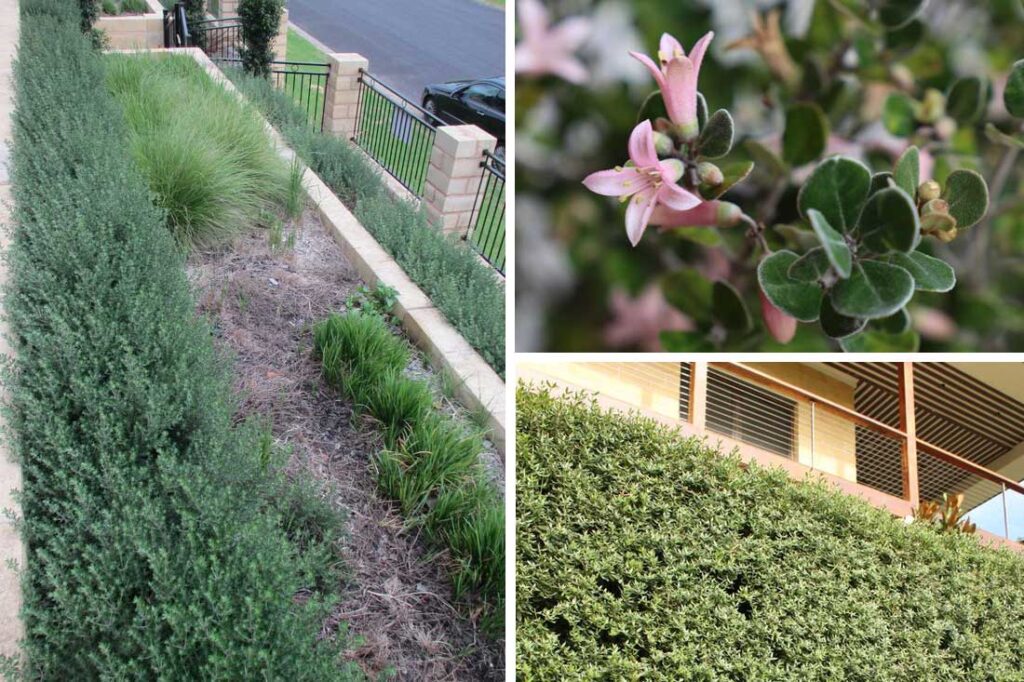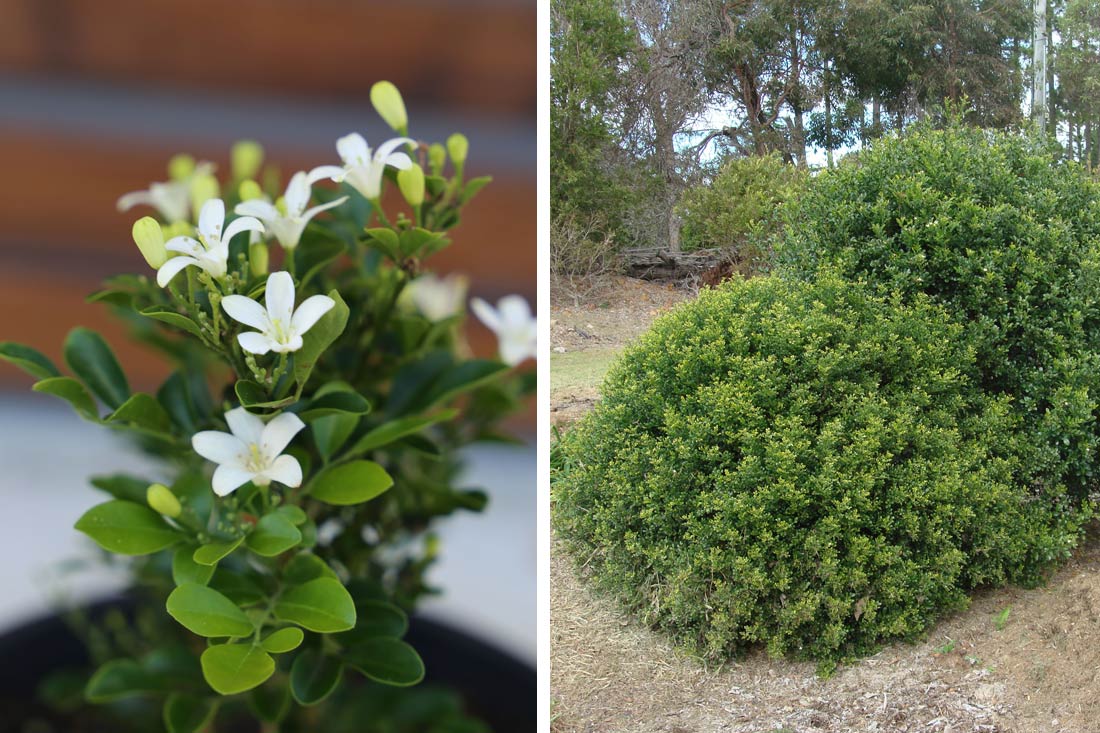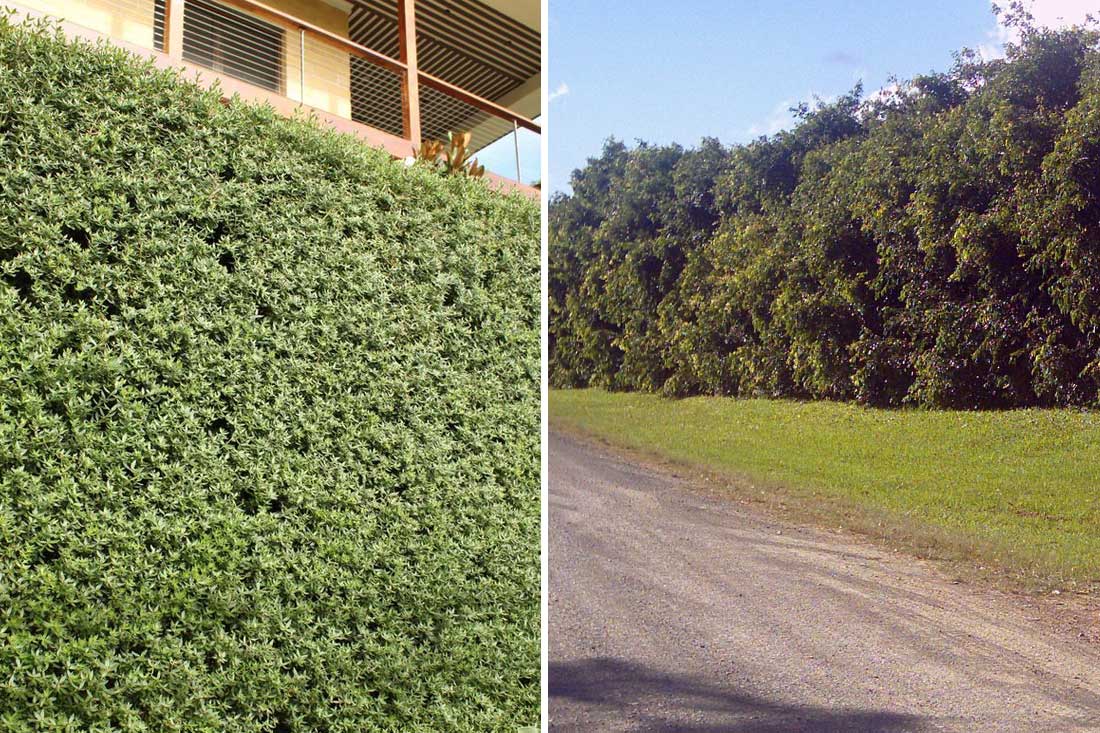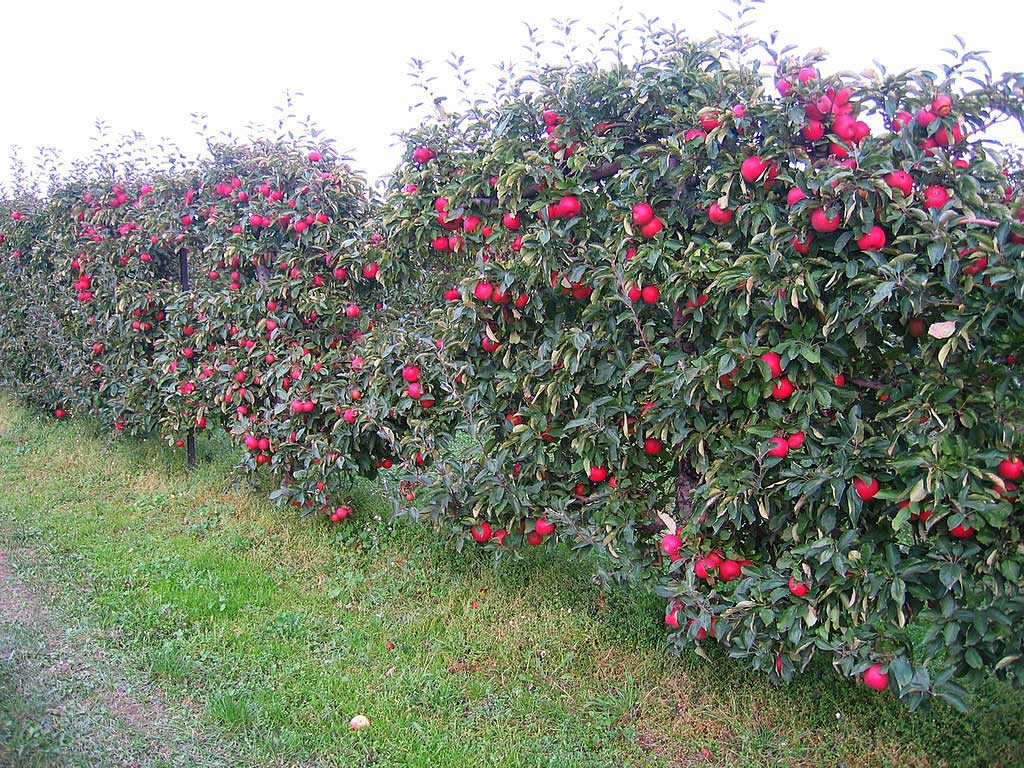North-facing slopes can pose a number of challenges related to the aspect in relation to the equator and the sun in Australia, as well as a narrow soil profile (often filled with rocks) that drains too quickly for most plants.
On top of these conditions which are already difficult enough, the wind, gravity and rain are constantly trying to erode what little topsoil you have away. This article will explain why north-facing slopes are tough in Australian landscapes, and provide a palette of hedges and screens that you can rely on in harsh conditions.
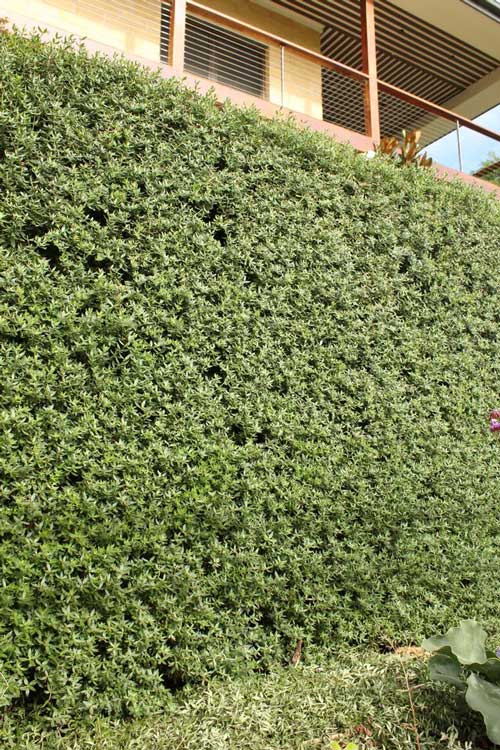
Slopes and embankments make tough growing conditions, but this Naringa Westringia screen is doing great.
Conditions of a North-Facing Slope in a Garden
North-Facing Aspect
A north-facing slope in a garden typically receives a significant amount of sunlight throughout the day in the Southern Hemisphere, which is where we are in Australia. Given its orientation toward the equator, a northern slope is exposed to sunlight for an extended period compared with a south-facing slope. This ample sunlight results in a warmer microclimate compared to slopes facing other directions as well.
Environmental Conditions of a Slope
The environmental conditions of a slope, regardless of its aspect, present another set of challenges and opportunities for gardening:
- Drainage: Slopes naturally facilitate better drainage compared to flat or depressed areas. Water tends to run off more quickly, which can prevent waterlogging but also necessitates more frequent watering or irrigation during dry periods. Drought-tolerant plants are often the best option for slopes, and drip irrigation can be used for thirsty plants on slopes without causing excess erosion.
- Soil Erosion: The inclination of a slope can encourage soil erosion, especially when the soil is uncovered during heavy rains and high winds. Planting ground covers or using terracing methods can mitigate this issue by stabilising the soil.
- Micro Climates: Slopes can create microclimates due to variations in sunlight exposure, wind patterns, and moisture levels. The top of the slope may be drier and more wind-exposed, while the base may retain more moisture.
- Plant Selection: Plants suitable for a sloped garden need to be carefully selected. Drought-tolerant species are ideal for the upper parts of the slope, while moisture-loving plants might thrive at the lower sections where water collects.
Consequences of Erosion on a Slope
Loss of Topsoil and Nutrients
Erosion on a slope can lead to the significant loss of topsoil, which is the most fertile layer of the soil. This layer contains essential nutrients and organic matter necessary for plant growth. When topsoil is eroded, the underlying soil layers are often less fertile and less capable of supporting healthy vegetation. The depletion of these nutrients can stymie plant growth and reduce the overall productivity of the garden.
Exposing Roots
As erosion progresses, it can expose the roots of plants growing on the slope. Exposed roots are more susceptible to damage from environmental factors such as sunlight, wind, and temperature fluctuations. This exposure can weaken plants, making them more vulnerable to disease and less stable, potentially leading to plant death and further soil destabilisation.
Preventative Measures
Terraforming
If you can afford to create level terraces, this is an incredibly effective way to improve the conditions of a sloped area. However, it’s not cheap, and it’s not necessary if you can control erosion and specify resilient plants.
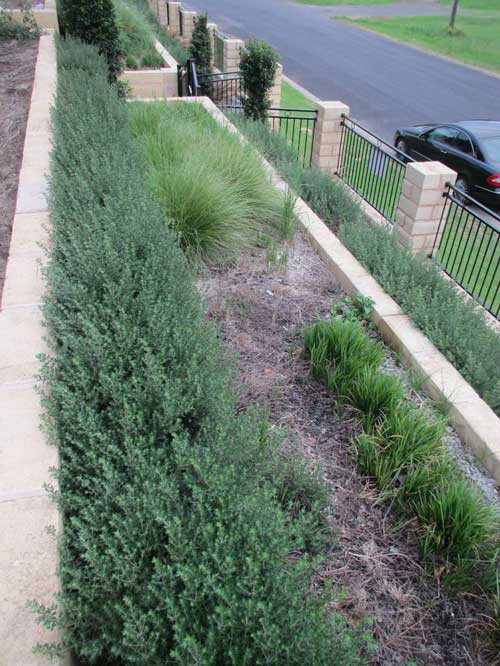
Naringa Westringia again, this time on a terraced slope.
Mulch
Applying mulch can be an effective method for preventing erosion on gradual slopes. Mulch helps to retain moisture in the soil, reduces runoff, and adds organic matter to the soil as it decomposes. However, mulch tends to slide down steeper slopes due to gravity, rendering it less effective in such areas.
Ground Cover Plants
Planting ground cover plants is a highly effective strategy for preventing soil erosion, especially in areas where mulch isn’t appropriate. These plants protect the soil from direct exposure to sunlight, wind, and rain, which are key contributors to erosion. Their roots physically hold the soil together, creating a network that stabilises the surface layer. Examples of effective ground covers include:
- Strappy-Leaf Plants: These plants have long, narrow leaves that can help slow down water flow and trap soil particles.
- Grasses: Grasses are particularly effective at controlling erosion due to their fibrous root systems that knit the soil together.
- Trailing Plants: These are ground covers which have trailing stems with vegetation that can physically protect the soil’s surface and crowd out weeds, if their growth is thick enough. Trailing plant roots tend not to be as beneficial as strappy plants for erosion control, however this is a generalisation and not a set rule.
Best Hedges and Screens for North-Facing Slopes
These plants are suited to drought and full sun conditions, which are typical of north-facing slopes in Australia.
They may or may not be resilient to erosion and exposed roots if you fail to control it with quality ground-covering plants. Browse our ground-covering native plants here: https://www.ozbreed.com.au/plant-ranges/native-shrubs-groundcovers/
Some of the plants are suitable for both drought and wet feet, as well as full sun and part shade, which makes them suitable for both raised areas of a slope, as well as depressed slopes which experience periodic drought and flooding. Check the Preferences section on each plant.
Some plants are tall hedges suitable for screening, and other plants are better suited for low hedges, border definition and roadside slopes with unobstructed line of sight.
Coastal Pink™ Correa alba ‘COR10’ PBR
Coastal Pink™ Correa is a new pink-flowered variety of the popular coastal Correa alba. It features a strong growth habit with less dieback, perfect in coastal situations. This medium-sized shrub or hedge has a noticeable pink tinge to its flowers, which adds a vibrant touch to any landscape. It is particularly attractive to birds, making it an ideal filler between trees or as a mass-planted shrub.
Size
- Height: Up to 2 metres
- Width: Up to 2 metres
Preferences
This plant prefers reasonably well-drained soil but is adaptable to most soil types. It thrives in full sun to light shade and can tolerate drought and frost once established. For optimal growth, it should be planted in a well-mulched garden using chunky mulch.
Where it Works
VIC, ACT, SA, WA, TAS, Southern NSW, Sydney (in well-drained soils).

Grey Box™ Westringia fruticosa ‘WES04’ PBR
Grey Box™ Westringia is a compact, drought-tolerant native hedge plant, ideal for creating low-maintenance borders and formal hedges. This hardy shrub features fine, grey-green foliage and produces small white to pale mauve flowers throughout the year. Its dense growth makes it an excellent alternative to traditional box hedging plants.
Size
- Height: 30-45 cm
- Width: 30-45 cm
Preference
Adaptable to various soil types. Thrives in full sun to part shade and withstands harsh conditions, including flooding, drought and coastal exposure. For a neat appearance, prune lightly after flowering to maintain its shape.
Where it Works
VIC, ACT, SA, WA, TAS, NSW, QLD
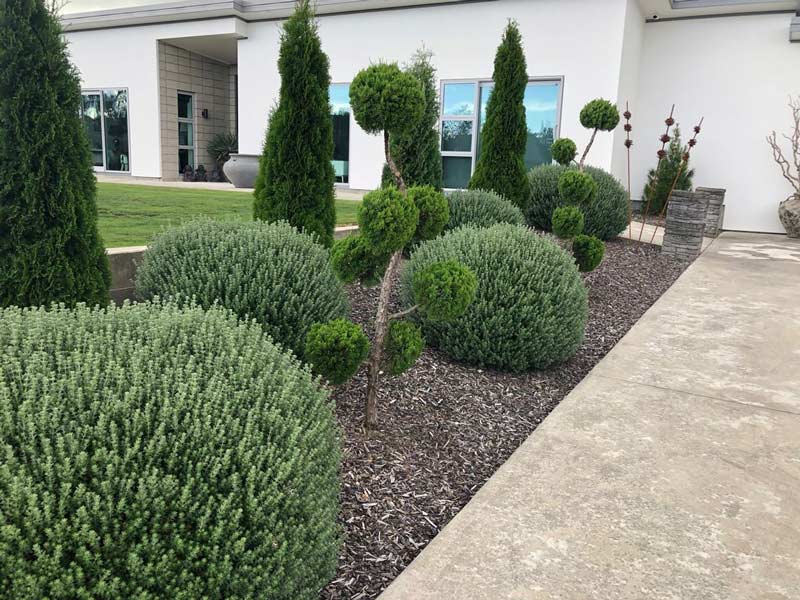
Naringa™ Westringia hybrid ‘WES01’ PBR
Naringa™ Westringia is an outstanding choice for medium to tall hedging on a slope. It has a tidy form and produces masses of mauve flowers in spring and intermittently at other times. This plant requires significantly less pruning than other Westringias, and in a natural setting, it may not need pruning at all.
Size
- Pruned: 1 metre high x 60 cm wide
- Unpruned: Up to 2.2 metres high x 1.5 metres wide
Preference
Suits sandy to well-drained clay-dominant soils but should avoid wet feet and depressed planting areas. Thrives in full sun to part shade and tolerates both cold and drought once established. For best results, water as required for 8-13 weeks until established, plant in a well-mulched garden using chunky mulch, and apply slow-release fertiliser in spring if needed. Prune to shape 1-3 times a year after flowering depending on your requirements, though it can be left unpruned in its natural form.
Where it Works
NSW, ACT, VIC, TAS, SA, WA, South East QLD (not suited to Northern QLD due to humidity)
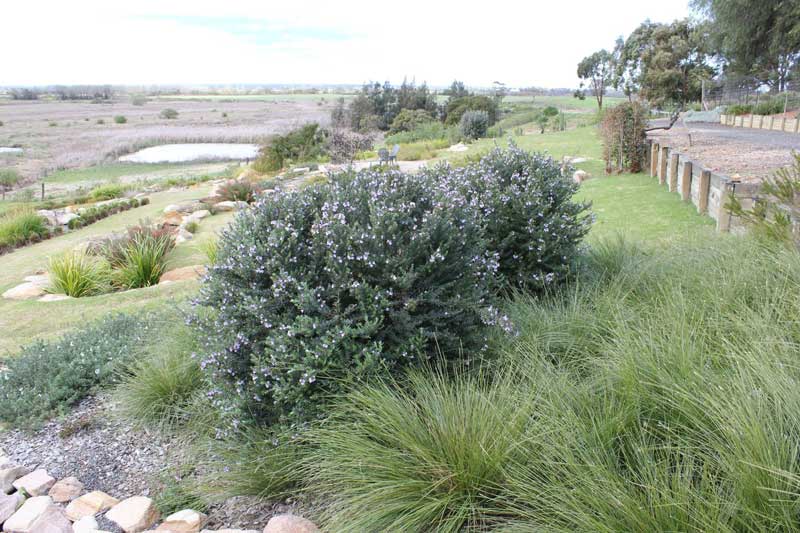
Better John™ Callistemon viminalis ‘LJ1’ PBR
Better John™ Callistemon is a compact and hardy low-growing shrub with attractive blue-green foliage and vibrant red flowers. This improved variety of the Callistemon viminalis variety ‘Little John’ is perfect for adding colour and texture to landscapes and gardens. It’s well-suited for use as a low hedge, feature plant, or in mass plantings on north-facing slopes.
Size
- Height: Up to 1 metre
- Width: Up to 1 metre
Preference
Adaptable to most soil types, including light and heavy soils. Thrives in full sun and can tolerate part shade. Highly wet feet and drought-tolerant once established and can handle frost. For optimal growth, water as required for 8-13 weeks until established, plant in a well-mulched garden using chunky mulch, and apply slow-release fertiliser in spring if needed. Pruning is only needed every two years to maintain shape.
Where it Works
QLD, NSW, ACT, VIC, TAS, SA, WA
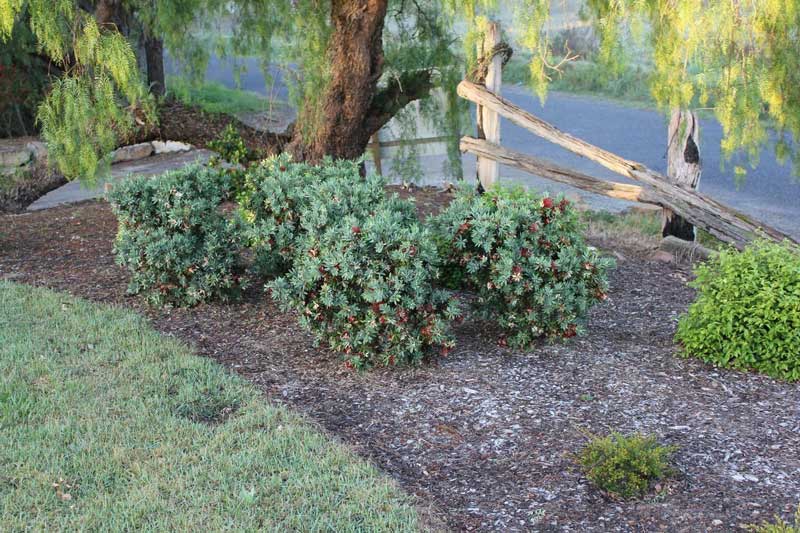
Macarthur™ Callistemon viminalis ‘LC01’ PBR
Macarthur™ Callistemon is a dense, bushy shrub with vibrant red flowers and fresh green-toned foliage. It combines two popular varieties, Little John and Captain Cook, resulting in a plant with superior flowering and a tidy growth habit. This versatile shrub responds well to pruning, making it suitable for formal hedges and landscape designs.
Size
- Height: Up to 1.8 metres
- Width: Up to 1.5 metres
Preference
Tolerates most soil conditions and thrives in full sun to part shade. It is frost, flooding and drought-tolerant once established. For best results, water as required for 8-13 weeks until established and plant in a well-mulched garden using chunky mulch. Apply slow-release fertiliser in spring if needed. Prune 1-3 times a year after flowering to maintain shape and density.
Where it Works
QLD, NSW, ACT, VIC, TAS, SA, WA
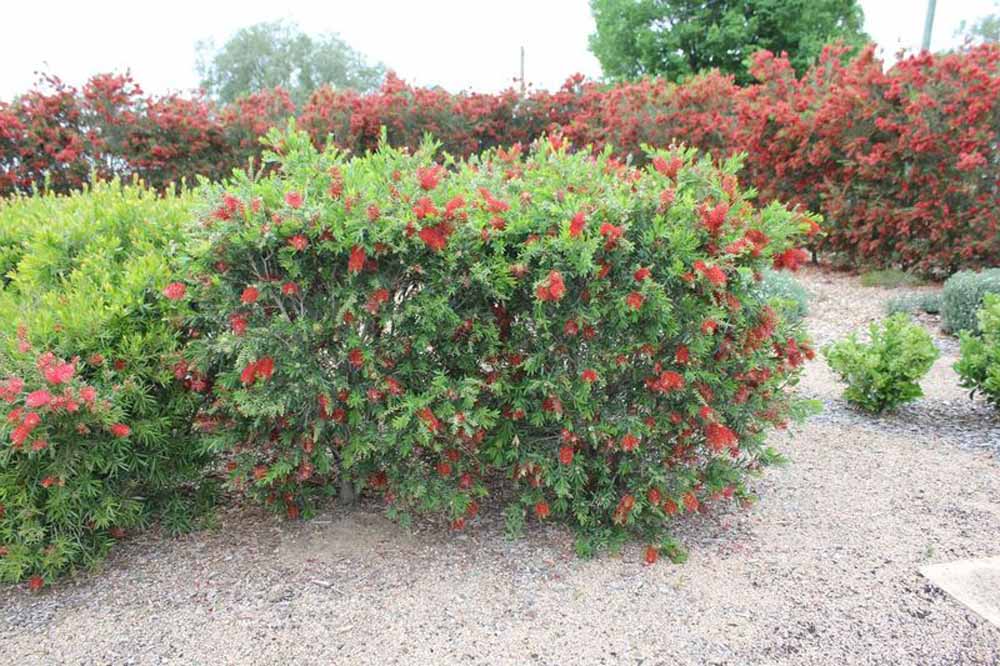
Slim™Callistemon viminalis ‘CV01’ PBR
Slim™ Callistemon is a bottlebrush variety with a narrow growth habit, ideal for tight planting areas and fencelines on a slope. This plant produces numerous flower buds in spring, which open to classic bottlebrush flowers throughout spring, summer, and autumn. It’s highly resistant to myrtle rust and phytopthora, and can tolerate cold and hot temperatures.
Size
- Height: Up to 3 metres
- Width: Up to 1.3 metres
Preference
Suits most soil types and thrives in full sun to part shade. Tolerates drought and frost once established. For best results, water as required for 8-13 weeks until established and plant in a well-mulched garden using chunky mulch. Apply slow-release fertiliser in spring if needed. Prune 1-3 times a year after flowering to maintain shape and density based on your requirements, or leave it unpruned in its natural columnar shape.
Where it Works
QLD, NSW, ACT, VIC, TAS, SA, WA
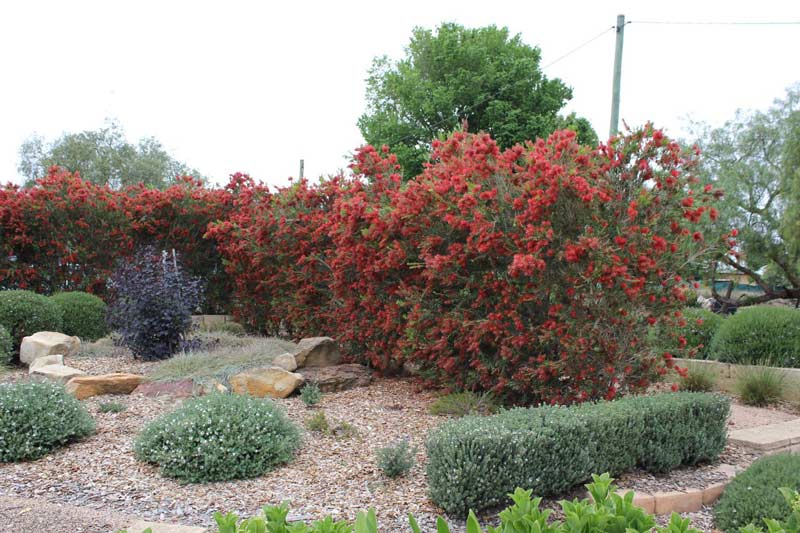
Cosmic White™ Rhaphiolepis indica ‘RAPH01’ PBR
Cosmic White™ Rhaphiolepis is a robust, evergreen shrub which produces an abundance of large white flowers in spring, with additional spot flowering throughout the year. This variety boasts very clean foliage and excellent disease resistance, making it a low-maintenance choice for public gardens, commercial landscapes and home gardens alike.
Size
- Height: 1.5 – 2 metres
- Width: 1.5 metres
Preference
Adapts well to sandy to most soils and tolerates full sun to moderate shade. It withstands frost, drought, flooding, and coastal conditions. For optimal growth, water as required for 8-13 weeks until established, plant in a well-mulched garden using chunky mulch, and apply slow-release fertiliser in spring if needed. Prune to shape every two years after flowering if required.
Where it Works
QLD, NSW, ACT, VIC, TAS, NT, SA, WA
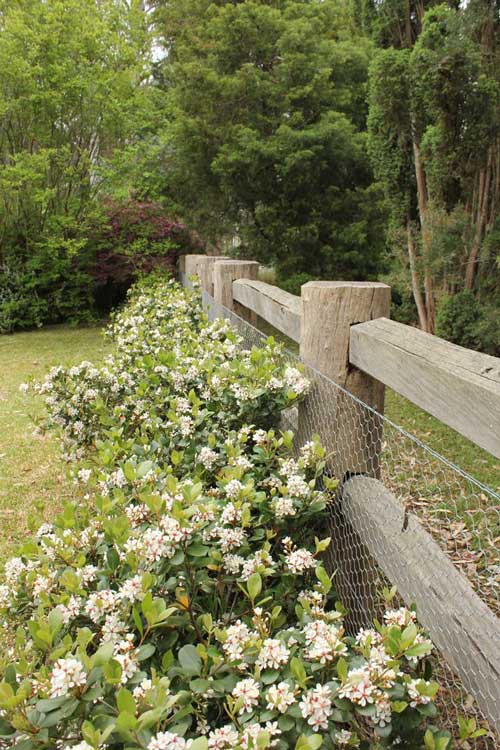
https://www.ozbreed.com.au/plant-ranges/hardy-exotic-range/cosmic-white-rhaphiolepis/
Cosmic Pink™ Rhaphiolepis indica ‘RAPH02’ PBR
Cosmic Pink™ Rhaphiolepis is an exceptionally tough, compact evergreen shrub with a mounding habit. It showcases large, showy pink flowers throughout spring and summer, offering both aesthetic beauty and an ecological resource. The plant is resilient in extreme weather conditions and can be paired with Cosmic White™ Rhaphiolepis for a contrasting display of height and flower colour. It rarely produces seeds, making it a low-maintenance non-weedy option.
Size
- Height: 50-80 cm
- Width: 50-80 cm
Preference
Thrives in full sun to moderate shade and is adaptable to sandy to clay soils. It tolerates frost, drought, flooding, and coastal conditions. For best results, water as required for 8-13 weeks until established, plant in a well-mulched garden using chunky mulch, and apply slow-release fertiliser in spring if needed. Prune to shape 1-2 times per year after flowering, depending on your requirements.
Where it Works
QLD, NSW, ACT, VIC, TAS, NT, SA, WA
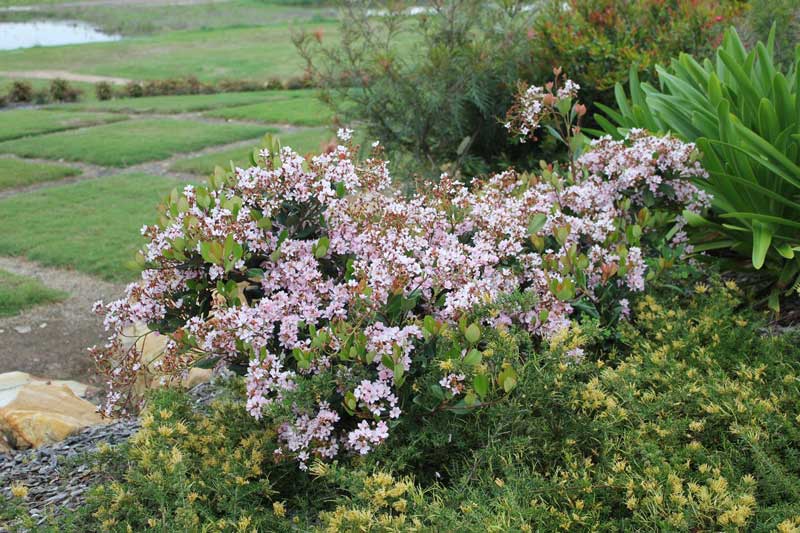
https://www.ozbreed.com.au/plant-ranges/hardy-exotic-range/cosmic-pink-rhaphiolepis/
Conclusion
North-facing slopes can be a tough growing environment with extreme sun and limited access to moisture. Installing mulch for gradual slopes or ground-covering plants for steep slopes can help to control erosion and improve soil quality.
Choosing drought-tolerant, full-sun-loving, and heat-tolerant plants are best suited for higher parts of a slope, and plants tolerant of periodic wet feet can be best for the bottom of a slope where water tends to pool.

